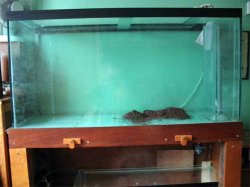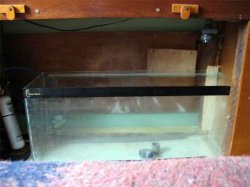keith00
Fish Fanatic
Hi,
I am in the process of converting a 4' reef tank into a planted aquarium and will be using as much of my present equipment as possible.
The halide lamps will be downgraded to Geisemann 150w 54ook.
The sump will become the top up reservoir.
The actinic tube will be used for a dawn and dusk effect coming on for half an hour before the main lights and half an hour after they go out.
The overflow weir outlets will be used for the inlet and outlet of the Tetratek x1200 filter and a dry tube for electrical cables so they can be passed under the tank.
I have CO2 guages that I once used on a DIY calcium reactor and a DIY bubble counter made from a test kit tube. I had to buy a solenoid for the night time cut off and will probably use a modified Maxijet 1200 as a diffuser.
So far I haven't spent any of my hard earned cash as I raised £260 from the sale of live rock and a few corals.
My aim is a high tech planted tank using plants suitable for beginners and although I have now set up the hardscape I am going on holiday in two weeks for a couple of weeks so will not be doing any more till I get back.
I have uploaded some pics using the browse button so hopefully you will be able to see the progress so far.
I am in the process of converting a 4' reef tank into a planted aquarium and will be using as much of my present equipment as possible.
The halide lamps will be downgraded to Geisemann 150w 54ook.
The sump will become the top up reservoir.
The actinic tube will be used for a dawn and dusk effect coming on for half an hour before the main lights and half an hour after they go out.
The overflow weir outlets will be used for the inlet and outlet of the Tetratek x1200 filter and a dry tube for electrical cables so they can be passed under the tank.
I have CO2 guages that I once used on a DIY calcium reactor and a DIY bubble counter made from a test kit tube. I had to buy a solenoid for the night time cut off and will probably use a modified Maxijet 1200 as a diffuser.
So far I haven't spent any of my hard earned cash as I raised £260 from the sale of live rock and a few corals.
My aim is a high tech planted tank using plants suitable for beginners and although I have now set up the hardscape I am going on holiday in two weeks for a couple of weeks so will not be doing any more till I get back.
I have uploaded some pics using the browse button so hopefully you will be able to see the progress so far.











 That tank size is more than sufficient for your plans. There are going to be a lot of fish in that tank.
That tank size is more than sufficient for your plans. There are going to be a lot of fish in that tank.  If you find hatchetfish in your LFS, and if they're healthy, chances are they've already been acclimated to the pH in your area. Baensch is an excellent guideline (I have volumes 1-3), and describes well the ideal conditions fish should be kept in, but many fish species are now farm-raised, and therefore accustomed to different levels than their wild counterparts would experience. If I can keep Angelfish and cardinal tetras in Miami, FL's liquid rock, you may be able to keep a nice group of hatchets. Pencil fish are pretty cool too. Another random note.
If you find hatchetfish in your LFS, and if they're healthy, chances are they've already been acclimated to the pH in your area. Baensch is an excellent guideline (I have volumes 1-3), and describes well the ideal conditions fish should be kept in, but many fish species are now farm-raised, and therefore accustomed to different levels than their wild counterparts would experience. If I can keep Angelfish and cardinal tetras in Miami, FL's liquid rock, you may be able to keep a nice group of hatchets. Pencil fish are pretty cool too. Another random note.